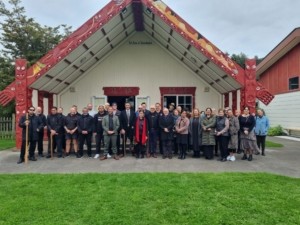- Home
- Research
- Te Kura i Awarua Rangahau Māori Centre
- Rangahau Māori Centre at EIT aims to drive community projects
Rangahau Māori Centre at EIT aims to drive community projects

Te Kura i Awarua, a new EIT Rangahau Māori Centre was opened at the Hawke’s Bay Campus of EIT Te Pūkenga in 2022.
Te Kura i Awarua, a new EIT Rangahau Māori Centre was opened at the Hawke’s Bay Campus of EIT | Te Pūkenga last year.
The pōwhiri, at Te Ara o Tāwhaki marae in September 2022, was attended by a number of stakeholders and interest groups, including Ngāti Kahungunu Iwi Incorporated Chair Bayden Barber, mana whenua from Ngāti Pārau, Te Whatu Ora (DHB) executives, Te Pūkenga Rangahau Research Forum members from Toi Ohomai, Rotorua and Tauranga, EIT Board members, local historians Professor Emerita Kay Morris Matthews and Pat Parsons, as well as a number of EIT and other community based researchers.
EIT Chief Executive Chris Collins said the launch of the centre was a significant moment in EIT’s history.
“For me personally it is important for a mainstream institution to be involved, engaged and committed to rangahau Māori.”
“We are showing our commitment to the people of the land and rangahau going forward, especially in the light of us becoming part of Te Pūkenga. It is also about being engaged in partnership with iwi and hapū and that means getting involved in the local environment.”
Chris thanked all those people who worked to make the centre a reality, in particular EIT Māori and Indigenous Research Professor David Tipene-Leach.
“I do want to acknowledge David for all the work he has done in providing leadership and the research projects, as well as his reputation and history he has given to this.”
Chris also thanked Professor Natalie Waran, EIT Te Pūkenga Executive Dean; and EIT Research Director Associate Professor Jonathan Sibley for their role in developing research at EIT. He also acknowledged EIT’s rangahau Māori Professor Annemarie Gillies, who was appointed earlier this year.

EIT Chief Executive Chris Collins; Professor Natalie Waran, EIT Executive Dean – Faculty of Education, Humanities and Health Science; EIT’s Rangahau Māori Professor Annemarie Gillies; EIT Māori and Indigenous Affairs Professor David Tipene-Leach; and EIT Research Director Associate Professor Jonathan Sibley; at the pōwhiri Campus to open Te Kura I Awarua, a new EIT rangahau (research) Māori Centre.
Professor David Tipene-Leach said the centre was a significant step forward for community research and vital for the development of “a strong research environment and as a means to effect real change in Aotearoa”.
“We have to start building up Māori capacity to do this work in order to get penetration into communities. We need to know what research communities value and want done and we need to develop more Māori capacity at EIT to do this research.”
“It is a critical time to begin building a strong cohort of young Māori researchers applying rangahau across all spheres of society.”
Professor Nat Waran said the opening of the centre was a momentus occasion.
“This rangahau centre is the embodiment of what our applied community centred approach to research is about. Five years ago, EIT committed to a research strategy that meant we would support and encourage applied research with a focus on working for and most importantly with our communities.”
“Already there has been some excellent work and a commitment for further national funding to address issues related to food security, health inequities and developing communities – and I have no doubt that there will be much more to come,” said Nat.
“I am proud of David, Annemarie and all of our team, including our research and innovation team – Research Director Jonathan Sibley and Research Manager Megan Allardice – for the work they have done to get us to this point. And a huge thank you to all of the rangahau researchers who are the ones who deliver on the community-centred approach to research.”
Dr Annemarie Gillies, EIT Professor Rangahau Māori, said the opening of the centre was significant.
“We don’t have a research centre in Ngāti Kahungunu and this centre is supported by Ngāti Kahungunu Iwi, hapū and whānau, our work will have impact across the region and in our communities.”
Te Kura i Awarua, which means ‘the precious objects (from Awarua)’ is located on EIT’s Hawke’s Bay Campus in Taradale. Professor Tipene-Leach and Professor Gillies will act as co-directors and the centre has an advisory board that includes Ngāti Kahungunu Iwi Incorporated Executive Chair Bayden Barber, Chris Collins and Chad Tareha, chairman of Ngāti Pārau, the mana whenua hapū for Ōtātara. The new centre will have a number of important research projects in health, food security, archiving and working with the rich history of hapū and iwi in the region and environmental challenges.

